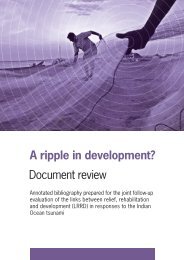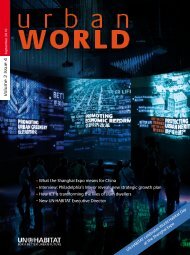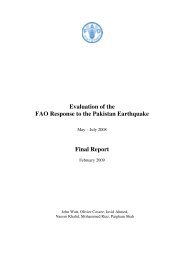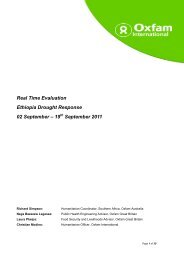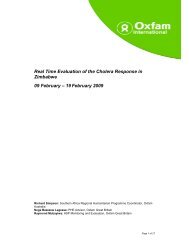Inter-Agency Real Time Evaluation of the Humanitarian ... - alnap
Inter-Agency Real Time Evaluation of the Humanitarian ... - alnap
Inter-Agency Real Time Evaluation of the Humanitarian ... - alnap
Create successful ePaper yourself
Turn your PDF publications into a flip-book with our unique Google optimized e-Paper software.
IA RTE <strong>of</strong> <strong>the</strong> humanitarian response to Pakistan’s 2010 Floods crisis<br />
segments <strong>of</strong> <strong>the</strong> affected population. Deductive analysis will <strong>the</strong>n guide <strong>the</strong> evaluators to <strong>the</strong><br />
o<strong>the</strong>r elements and dimension (as displayed in <strong>the</strong> IA RTE Framework below) on which <strong>the</strong><br />
evaluation should specifically focus. In general, <strong>the</strong> IA RTE will focus in large part on <strong>the</strong><br />
effectiveness and efficiency <strong>of</strong> <strong>the</strong> coordination and management systems, addressing critical<br />
issues related to both <strong>the</strong> provision <strong>of</strong> relief and to <strong>the</strong> transition to recovery.<br />
IA RTE Framework, including Key Issues & Key Questions<br />
The IA RTE Framework is a model that intends to display crucial characteristics <strong>of</strong> an ‘ideal<br />
humanitarian response’. It was developed to be applied for natural disasters and rapid external<br />
evaluation. Moreover, <strong>the</strong> Framework serves a communication tool between all stakeholders<br />
and can <strong>the</strong>refore be slightly adapted to local issues and relevant opportunities for learning. The<br />
IA RTE Framework intends to provide <strong>the</strong> evaluators and <strong>the</strong> HCT with guidance on <strong>the</strong> most<br />
critical questions and issues to be evaluated. Ideally, <strong>the</strong> IA RTE Framework should be shared<br />
with all relevant stakeholders. It is expected that evaluators use <strong>the</strong> Framework as main<br />
reference tool for <strong>the</strong>ir assessment.<br />
To reiterate, evaluators should try to first focus on <strong>the</strong> outputs and outcomes <strong>of</strong> <strong>the</strong><br />
humanitarian response at <strong>the</strong> level <strong>of</strong> <strong>the</strong> affected population, especially by answering one <strong>of</strong><br />
<strong>the</strong> main questions <strong>of</strong> <strong>the</strong> Framework – “How adequate was <strong>the</strong> response as a whole, and what<br />
operational results as well as positive and negative outcomes for <strong>the</strong> affected population did<br />
it produce?”. Deductive analysis should <strong>the</strong>n guide <strong>the</strong> evaluators to <strong>the</strong> o<strong>the</strong>r relevant<br />
dimensions as outlined below in <strong>the</strong> Framework.<br />
Please find below <strong>the</strong> IA RTE Framework as Table<br />
Riccardo Polastro, Aatika Nagrah, Nicolai Steen and Farwa Zafar<br />
65







